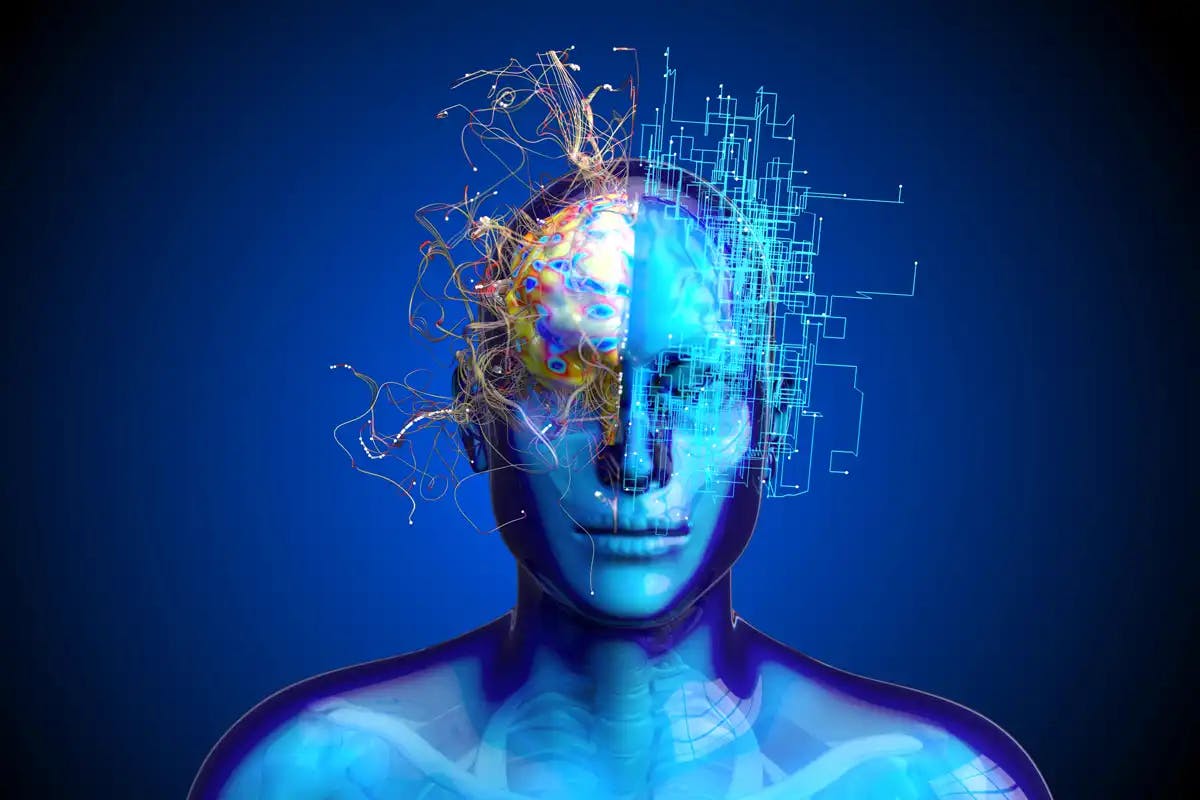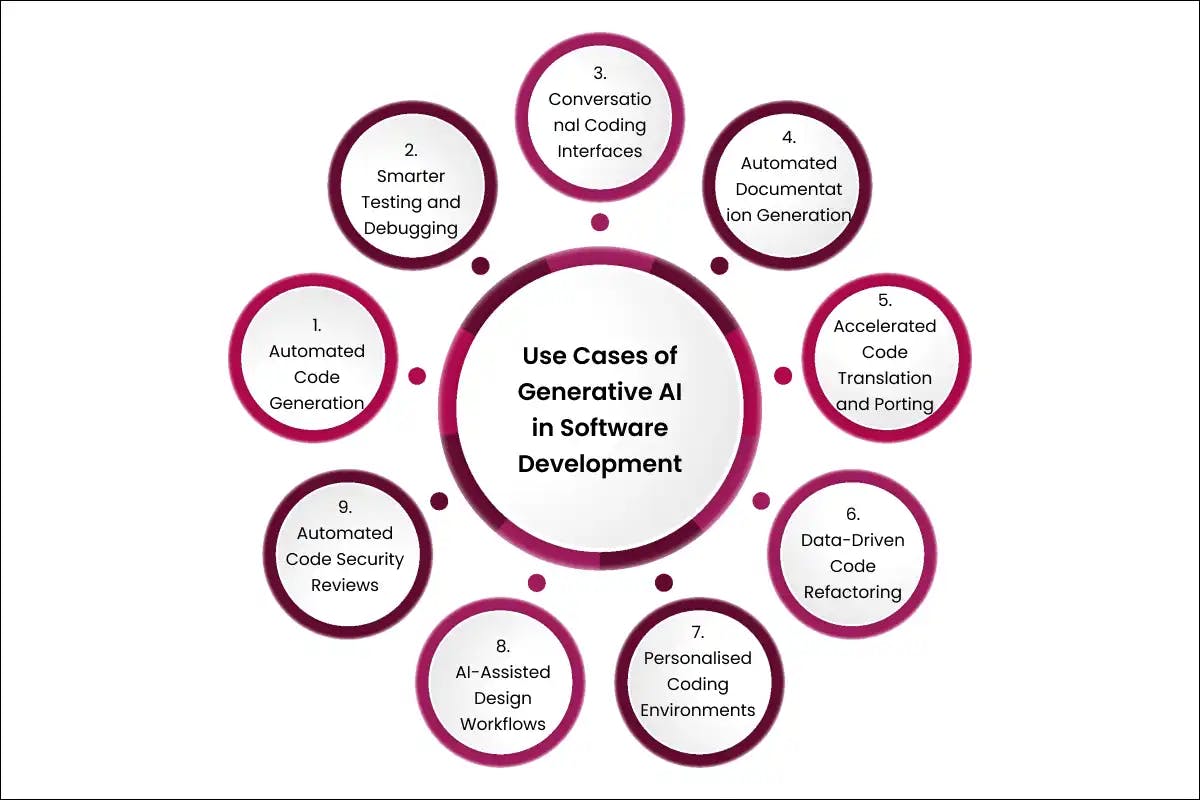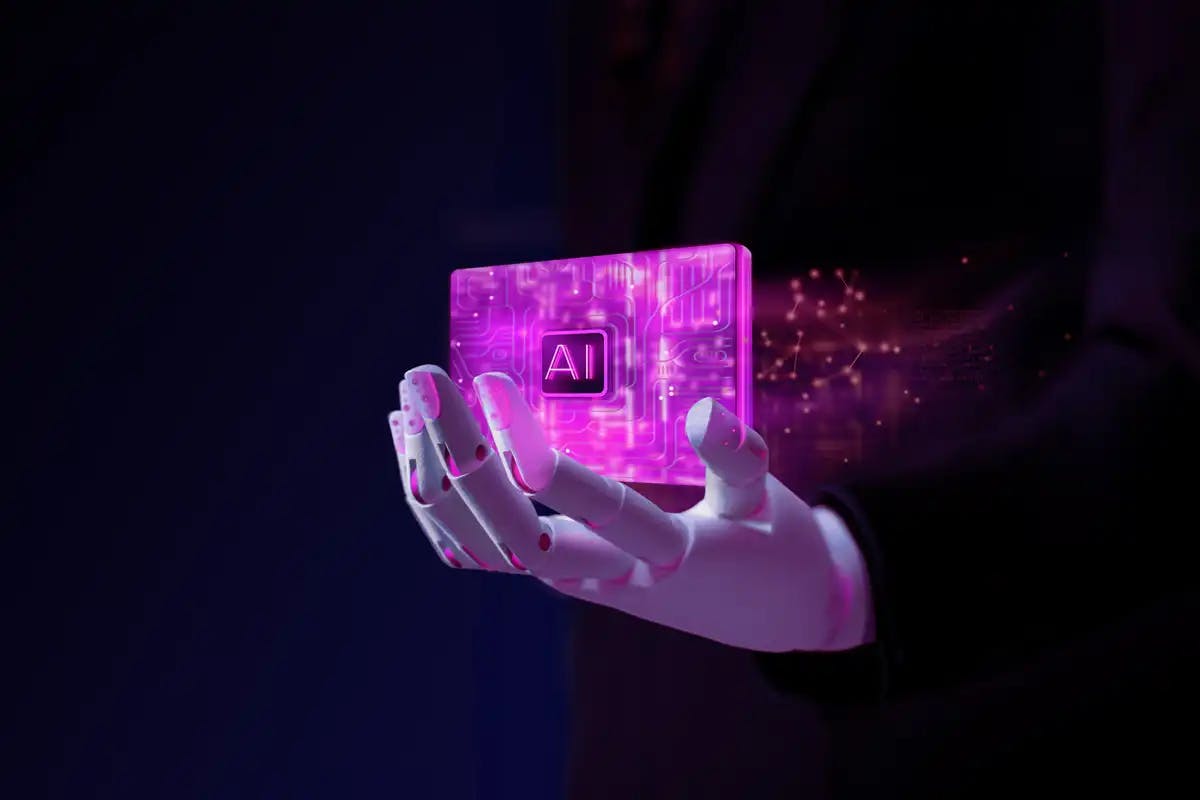


The development of highly advanced generative AI systems such as ChatGPT has generated significant enthusiasm about their capacity to change the world of software development. With companies actively investigating new applications, here are several of the primary manners in which generative AI looks set to shape the future of software development:

One of the most direct applications of generative AI is automated code generation. Instead of simply providing autocomplete suggestions, advanced AI models can now generate entire functions, classes, and even complex database queries tailored to a specific codebase's context.
For example, by analyzing existing code, data schemas, and documentation, AI agents could produce a customized CRUD REST API for a mobile app backend.
Developers could provide some high-level requirements in plain English, and the AI could take care of the heavy lifting involved in implementing the nitty-gritty details. This automates a lot of the repetitive, low-level coding work that bogs developers down.
AI code generation also enables quick prototyping of projects by producing boilerplate code for various programming languages and frameworks. For instance, an AI assistant might spit out starter code, folder structures, configuration files, build scripts, and instructions customized to a developer's tech stack choices.
Advanced generative models like GitHub Copilot provide inline code completions powered by deep learning. Copilot analyses the context and developer intent to suggest entire lines or even functions on the fly. This allows developers to describe what they want to accomplish in natural language, and Copilot translates those high-level intentions into robust code.
Here are two examples of tools that use generative AI for automated code generation:
This autocompletion tool uses deep learning to suggest entire lines and functions in over 20 programming languages.
DeepCoder - This research project from Microsoft uses machine learning to automatically generate code from specifications and input-output examples.
Generative AI has significant capability to assist with code testing and debugging as well. Modern deep learning models can analyze large codebases with far greater speed and accuracy than humanly possible through manual code reviews.
AI coding assistants may function like extra team members by continually reviewing code changes and proactively flagging bugs, security flaws, performance bottlenecks, and other issues early in the development process. This allows problems to be addressed before they snowball into bigger headaches down the line.
For testing, AI can automate the creation of comprehensive test cases that go beyond basic scenarios to cover edge cases, failures, and real-world usage patterns. Skilled developers spend considerable time dreaming up crafty test cases to break their code, which generative AI could help accelerate. The expanded test coverage enabled by AI yields more robust, resilient software.
When bugs inevitably emerge, AI assistants can again analyze code context and usage data to provide thoughtful debugging recommendations. They can trace through complicated execution paths that human engineers might overlook. And they can pinpoint not just where code cracks emerge, but also how to address the root causes instead of merely the symptoms.
So generative AI delivers immense advantages for identifying problems early through enhanced testing, as well as faster resolution by helping engineers during debugging. These benefits could greatly boost software reliability and reduce costly issues making it into production.
Here are two examples of tools that use generative AI for smarter testing and debugging of code:
This tool uses machine learning to analyse code executions and provide insights into bugs and performance problems.
Today's developers must constantly consult documentation and references to look up syntax, study examples, and research coding approaches. Generative AI promises to minimize this need by enabling conversational coding interfaces.
Rather than digging through docs, developers could simply ask their AI assistant natural language questions like "How do I implement authentication in React Native?" or "What's the Python syntax for reading a file?"The AI would understand the user's queries, analyze the context and code, and give an accurate response to its user.
AI coding assistants integrating IDEs and developer tools could also allow programmers to commit changes, switch git branches, run tests, merge PRs, and more via voice commands or text chats. This would reduce context switching compared to clicking around in different apps and sites.
In essence, conversational interfaces promise to eliminate wasted time previously spent Googling, browsing docs, and hunting for code snippets. Developers get answers and advice tailored to their exact needs instantly within their native workflows.
However, conversational AI still needs to be adept enough to replace thorough API and framework documentation. Generative tools provide helpful pointers and reminders, but they cannot match the depth and breadth of official manuals and guides. So documentation will remain vital alongside AI assistants.
Here are two examples of tools with conversational interfaces for coding powered by generative AI:
This advanced auto completion tool allows developers to query code examples and documentation by describing what they want to implement in plain English.
Speaking of documentation, generative AI holds immense promise to automate the traditionally tedious process of writing software documentation. Given code and some usage context, AI models can auto-generate polished API references, library guides, and detailed application docs.
The AI could produce documentation in a variety of formats like Markdown, HTML, PDFs, and interactive web interfaces. For APIs and libraries, it might generate nicely formatted documentation with code samples for each module, class, and method. For apps and services, it could produce help guides and reference manuals explaining how everything fits together.
Unlike traditional templates, AI documentation can be highly customized to each project by providing specifications for what to include or exclude. Developers could list the APIs to document, usage examples to demonstrate, diagrams to render, and other parameters. The AI would then adapt the output accordingly.
Documentation generation via AI frees up significant time previously spent writing tedious repetitive docs. This allows developers to focus on higher-value tasks like designing architecture rather than explaining it after the fact.
That said, AI-produced documentation still requires human oversight to verify accuracy and fill any gaps. But used wisely, it can liberate developers from the most monotonous elements of documentation while retaining high quality.
Here are two examples of tools that use generative AI for automated documentation generation:
This research project from OpenAI can generate documentation for code by analysing functions, inputs, outputs, and in-code comments. It produces organized Markdown docs explaining usage and examples.
This open-source tool autogenerates API reference docs and help guides by parsing JSDoc comments in code. Developers can customize templates for look and feel.
Code translation and porting represent another area ripe for AI assistance. Manually converting code from one language or framework to another is tedious and error-prone. But generative models can automate much of this grunt work.
By analyzing source code, AI tools can convert programs across languages like Java, C, Python, and JavaScript while preserving semantics, behavior, and performance. The generated code minimises adaptations needed to run in the target environment. This streamlines porting projects to new tech stacks.
When integrating external libraries or migrating older code to modern stacks, AI helpers can automatically handle dependencies, wrappers, and compatibility layers. For example, an AI assistant could take a library written in Python 2 and upgrade it to Python 3 while managing all the nitty-gritty details seamlessly.
Intelligent code translation allows developers to focus on big picture architectural shifts rather than line-by-line conversions. It removes friction from bringing legacy systems forward and building services accessible across tech stacks. As multi-language and cross-platform development grows more prevalent, AI-powered translation offers a huge boon.
However, human oversight is still required to train translation models on target languages and verify the transformed code operates correctly before shipping. The AI provides a starting point to be refined rather than an instant solution.
Here are two examples of tools that use generative AI for accelerated code translation and porting:
This research project converts code between C#, Java, and Python using supervised learning. It adapts code to preserve functionality in the target language.
This tool uses machine learning to translate code across web frameworks like Angular, React, and Vue. It automatically manages dependencies and syntax changes during conversion.
Technical debt accumulation in large, long-running projects drags down developer productivity over time. Large numbers of tangled legacy codes become burdensome to maintain and extend. This prompts the need for refactoring via code reorganisation, streamlining, and cleanups.
Traditionally, engineers refactor based on intuition and experience with messy codebases. However generative AI models can analyze projects far more comprehensively and objectively. AI assistants can traverse dependency graphs and execution paths at scale, quantifying complexity, coupling, cohesion, and other structural traits.
From this data-driven analysis, AI can provide extremely granular recommendations for improving code. Examples include:
In aggregate, these micro-refactorings guided by AI keep code cleaner and maintainable as projects evolve. An AI assistant also explains refactoring advice through natural language and code comments, helping developers understand suggested changes.
Generative AI enables large-scale refactoring that would be impossible manually. Human engineers still define overall restructuring goals and evaluate the impact of changes. But AI identifies and executes improvements at a granular level producing higher quality, optimised code.
Here are two examples of tools that use generative AI for data-driven code refactoring:
This IDE plugin analyses code complexity metrics to identify refactoring opportunities. It provides context-aware suggestions like extractions, encapsulations, etc. to improve structure.
This tool uses machine learning on corpora to recommend refactorings that improve maintainability. It provides semantic reasoning behind the suggestions to aid developer understanding.
While generative AI provides generalised coding knowledge, assistants can also personalise support tailored to individual developers. Personalised recommendations and workflows boost productivity by automating repetitive tasks according to each user's preferences.
For example, by observing the code an engineer writes over time, an AI coding assistant could learn their favoured style conventions, variable naming schemes, code organisation patterns, and other quirks. The AI would then customize generated code, autocomplete suggestions, and refactoring advice to match that preferred style.
AI assistants could also automatically tune code analysis rules and quality checks to match the standards used within a codebase rather than generic linting. For instance, the AI might detect if a project uses tabs vs. spaces and 4-space indentation. The tailored linting feedback would then follow accordingly rather than forcing arbitrary defaults.
Beyond styling, an AI assistant could learn higher-level patterns from a developer's work. It might recognize commonly used libraries, reusable functions extracted across projects, commenting motifs, debugging strategies, and design approaches.
Over time, this allows the AI to provide increasingly personalised productivity boosters like:
Rather than imposing one-size-fits-all suggestions, the AI progressively adapts to each developer's needs. It automates the mundane while staying out of their way, allowing engineers to focus on challenging design problems versus repetitive coding tasks.
Here are two examples of tools that provide personalised coding environments powered by generative AI:
This advanced autocomplete tool customises suggestions based on an individual's coding history and style.
This IDE plugin builds developer profiles based on their work to make personalised recommendations.
Thus far we've focused mainly on generative AI's code generation capabilities, but the technology also holds tremendous capability for design workflows. Creative roles like UX designers can achieve significant boosts through AI design partners.
Most prominently, visual design generation models like DALL-E 2 enable designers to instantly translate text prompts into novel images. For example, a prompt like "a mobile app for mountain bikers with neon sci-fi aesthetics" might produce a vibrant phone interface against a cyberpunk backdrop.
Designers can iterate on prompts to explore radically different concepts. The AI becomes a springboard for ideation, allowing designers to materialise imaginative concepts and see capability aesthetic directions long before creating detailed mocks and assets.
Interface and experience designers can also prototype quickly by describing UI components and layouts in text for the AI to render. This provides early validation of ideas and interaction flows before engineering begins. Generative design allows for more flexibility and experimentation in the high-level planning stages of development.
Of course, while AI aids rapid visualisation, designers still lead on creative direction, iterations, and final polish. However, by offloading repetitive design tasks, they can spend more time on higher-level strategic challenges. AI becomes an intuitive partner amplifying human creativity rather than replacing it.
Here are two examples of tools that provide AI-assisted design workflows powered by generative AI:
This research lab built an AI assistant called Claude that translates text prompts into UI mockups, icons, and design assets.
This platform lets designers describe visuals in natural language for the AI to generate.
On the other side of creativity, generative AI also empowers automated security and compliance analysis. AI can be trained to deeply understand security vulnerabilities and compliance risks. Assistants can then analyze code for adherence to best practices, known dangers, and regulatory requirements.
For example, after digesting patterns from the OWASP top vulnerabilities list, an AI assistant might flag any dependencies with known vulnerabilities, SQL injection risks, broken access controls, and other issues. This provides a preliminary security sanity check.
When developing artificial intelligence assistants, focusing on compliance is key. To ensure standards are met, AI can be educated on regulations such as HIPAA, PCI DSS, and GDPR. The technology would then examine code for any noncompliance issues, such as missing encryption, insufficient logging practices, or improper handling of information as outlined in the relevant rules. By following this process, oversights regarding compliance can be decreased.
Through the utilisation of artificial intelligence-enabled scanning, the software undergoes automated security testing that is significantly more comprehensive than any human-led code audit could achieve. The artificial intelligence system effectively codifies the aggregated expertise of the entire security community to evaluate software applications. Furthermore, ongoing security training serves to continually broaden the knowledge foundation of AI assistants, thereby enhancing their ability to protect software from potential vulnerabilities.
Integrating these automated checks directly into developer workflows surfaces problems immediately during coding before bad habits solidify. Early awareness of vulnerabilities from an objective AI perspective leads to more secure, resilient end products.
Here are two examples of tools that provide automated code security reviews using generative AI:
This AI pair programmer flags security vulnerabilities and compliance issues as code is written. It cross-references patterns against the knowledge of OWASP Top 10, PCI DSS, HIPAA, etc. to proactively surface risks.
This platform uses machine learning algorithms trained on vulnerability databases to scan codebases for security weaknesses.
To summarise, generative AI in software development brings significant improvements across the entire software development process. Nearly every step of creating, evaluating, troubleshooting, documenting, and planning software can become more efficient and effective with AI aid. When coding, testing for issues, fixing bugs, documenting procedures or designing layouts, artificial intelligence assistance can enhance the standard of work and quicken the pace at each phase of development.
While the advantages are considerable, companies must carefully consider possible drawbacks relating to data privacy, model prejudice, coaching expenses, and expertise disruption as AI further integrates into engineering. Instead of widespread substitution of developers, the optimal situation combines the strengths of human and artificial intelligence.
Thoughtful implementation of generative AI ensures technologies like ChatGPT make developers' lives easier without undermining human autonomy and judgment. AI assistants handle coding tasks while engineers focus on creative solutions to complex problems. Together, man and machine can build the future of software.
Codiste, one of the best Generative AI Development Companies, is spearheading the use of generative AI for software development. Our goals involve advancing natural language processing and computer vision through pioneering novel applications of generative AI. These applications assist developers in constructing intuitive interfaces and experiences. At Codiste, we synergize human ingenuity with artificial intelligence. This enables engineering teams to exponentially augment their productivity across platforms. Whether it's automating coding or deriving data-driven insights, our Gen AI's solutions are charting the path for the future of software development.




Every great partnership begins with a conversation. Whether you’re exploring possibilities or ready to scale, our team of specialists will help you navigate the journey.